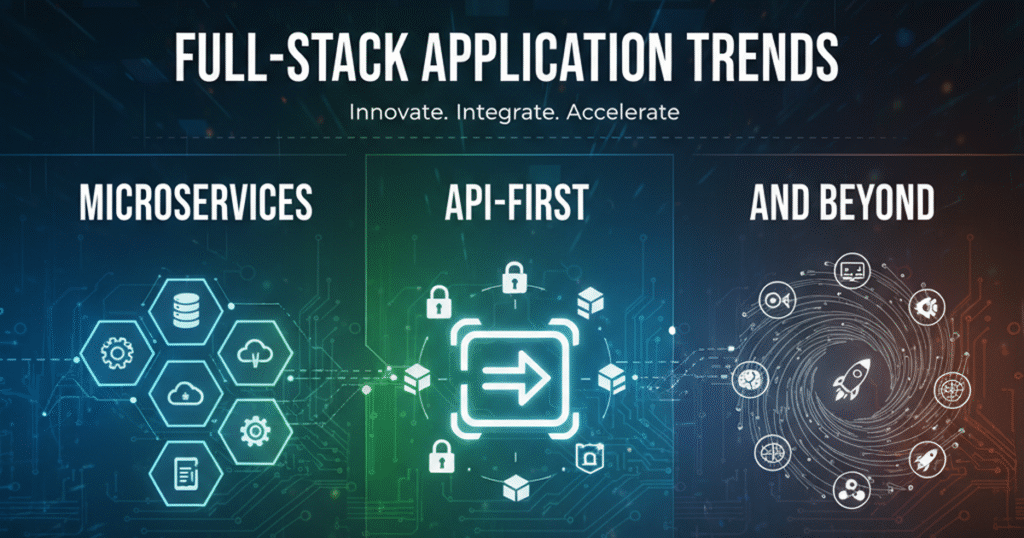Why Full-Stack Application Trends Matter in 2025
The way we build applications has gone through a massive transformation over the past decade. Traditional monolithic systems, while reliable, often struggled with scalability, speed of delivery, and flexibility. In contrast, today’s digital businesses demand architectures that can scale on demand, integrate seamlessly with third-party systems, and adapt quickly to evolving customer expectations.
This is where ‘Full-Stack Application Trends’ come in. From ‘Microservices Architecture’ and ‘API-First Development’ to ‘Cloud-Native Applications’, the modern stack is no longer about just ‘front-end plus back-end’. It’s about building distributed, secure, and resilient ecosystems that can thrive in a rapidly changing technology landscape.
In this blog, we’ll explore the latest trends shaping full-stack development in 2025 — drawing insights from both industry blogs and academic research — and discuss how companies can leverage these shifts strategically.

Microservices Architecture: Benefits, Complexity, and Management Challenges
‘Microservices Architecture’ has become the backbone of many modern full-stack applications. Instead of one giant codebase (the monolith), applications are now broken down into smaller, independently deployable services.
Why Microservices Work
Independent scaling: A payment service can be scaled separately from a search service.
Fault isolation: A failure in one service doesn’t necessarily take down the entire system.
Agility: Teams can deploy features faster without waiting for massive release cycles.
For example, Netflix, Amazon, and Uber all rely heavily on microservices to serve millions of users simultaneously.
The Challenges
However, microservices are not a silver bullet. Managing dozens or even hundreds of services introduces complexity. Inter-service communication, distributed transactions, and debugging across multiple services can overwhelm teams. That’s why orchestration tools like ‘Kubernetes’ and service meshes like ‘Istio’ have become essential.
In short, microservices deliver flexibility, but they also demand strong DevOps maturity.
API-First Development: From Best Practice to Industry Standard
APIs are no longer side projects or afterthoughts. In ‘API-First Development’, the application’s APIs are designed before the underlying logic is built.
The Rise of APIs as Products
Companies treat APIs as products in themselves, complete with documentation, testing, and lifecycle management.
This approach enables ‘faster integrations’ with partners, mobile apps, and external services.
Standardization and governance help ensure consistency across teams.
REST, GraphQL, and gRPC
While REST remains dominant, developers are increasingly adopting ‘GraphQL’ (for flexible queries) and ‘gRPC’ (for high-performance communication). For instance, GitHub’s public GraphQL API allows clients to fetch exactly the data they need, reducing over-fetching and under-fetching issues.
API-First isn’t just a trend anymore; it’s the default standard for scalable full-stack development.
Cloud-Native Applications: Scalability, Reliability, and DevOps Integration
The cloud has become the natural habitat for modern applications. Cloud-Native Applications are designed to take full advantage of cloud platforms, running on containers and orchestrated by systems like Kubernetes.
What Cloud-Native Brings
Elastic scalability: Applications can scale up or down automatically.
Reliability: Redundancy across regions ensures high availability.
CI/CD integration: Teams can deliver updates frequently without downtime.
The Cultural Shift
Cloud-native isn’t just about infrastructure. It represents a cultural change where DevOps and platform engineering play a central role. Teams embrace automation, continuous testing, and infrastructure-as-code to keep up with the fast pace of releases.
However, this adoption also brings challenges, particularly around supply chain security, container image scanning, and dependency management.
Event-Driven Architectures and Async Communication
Modern systems are shifting away from synchronous, request-response models toward ‘event-driven architectures’.
Why Event-Driven Matters
Scalability: Systems like Kafka or RabbitMQ handle millions of events per second.
Loose coupling: Services don’t need to know about each other — they just consume events.
Real-time experience: Event-driven systems enable instant notifications, streaming, and analytics.
For example, ride-sharing platforms use event-driven systems to match drivers with riders in real time.
The API Evolution
Beyond messaging systems, ‘gRPC’ and ‘GraphQL’ are replacing traditional REST in many scenarios, improving performance and flexibility in microservice communication.
Security & Observability: Core Pillars of Modern Full-Stack
As systems become more distributed, the attack surface widens. Security can no longer be an afterthought.
Security by Design
Shift-left security: Embedding security checks early in the development lifecycle.
API security gateways: Protect APIs against injection and denial-of-service attacks.
Zero-trust principles: Every request is authenticated and authorized, even inside the network.
Observability as a Necessity
You can’t fix what you can’t see. Logs, metrics, and traces have become essential in distributed systems. Tools like ‘Prometheus’, ‘OpenTelemetry’, and ‘Grafana’ help developers monitor system health, detect anomalies, and troubleshoot effectively.
Together, security and observability ensure that modern applications remain not only scalable but also trustworthy.
Developer Productivity: Low-Code, Serverless, and Team Evolution
The demand for faster delivery cycles has given rise to ‘low-code platforms’ and ‘serverless computing’.
‘Low-code tools’ allow business teams to prototype quickly.
‘Serverless platforms’ (AWS Lambda, Azure Functions) let developers focus on business logic rather than managing infrastructure.
But technology is only half the story. Research shows that ‘team structure’ must evolve to support these tools. DevOps, platform teams, and cross-functional squads are essential for harnessing the power of microservices and APIs.
Resilience and Reliability: Chaos Engineering and Testing
Distributed systems fail in unexpected ways. Companies are now adopting ‘resilience engineering’ practices to test their systems under failure conditions.
Chaos engineering (popularized by Netflix) introduces controlled failures to test robustness.
Circuit breakers and retries ensure services remain functional during partial outages.
Fault injection frameworks simulate real-world problems before they hit production.
Reliability is no longer a nice-to-have. In industries like finance or healthcare, resilience is a matter of trust and compliance.
Future Outlook: Beyond Microservices and APIs
The future of ‘Full-Stack Application Trends’ lies at the intersection of automation and intelligence.
AI-driven DevOps: Predictive scaling, anomaly detection, and automated incident response.
Self-healing systems: Applications that can detect and fix issues without human intervention.
Hybrid and multi-cloud strategies: Avoiding vendor lock-in while leveraging best-in-class services.
Organizations that adopt these trends early will be better positioned to innovate and stay ahead of the competition.
Conclusion: Strategic Adoption of Full-Stack Trends
In 2025, full-stack development is no longer just about combining front-end and back-end skills. It’s about embracing distributed architectures, designing APIs as products, building cloud-native applications, and ensuring systems are secure, observable, and resilient.
The journey isn’t without challenges — from managing microservices complexity to ensuring supply-chain security — but the payoff is clear: agility, scalability, and innovation at scale.
For organizations, the key is to adopt these trends strategically, not just because they’re popular. By treating them as cultural shifts rather than buzzwords, companies can unlock the true potential of Full-Stack Application Trends and position themselves as leaders in the digital economy.
Search
Categories

